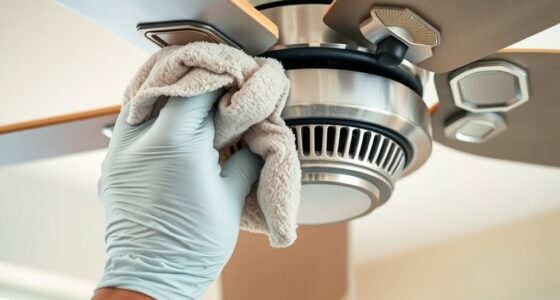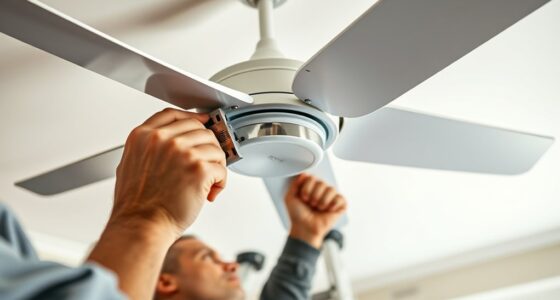To lubricate your ceiling fan, first turn off the power and carefully locate accessible bearings or joints near the motor and blade arms. Clean these areas to remove dust and old grease, then apply a lightweight machine oil or similar lubricant precisely into the lubrication points using a syringe or applicator. Rotate the blades manually to evenly distribute the lubricant, then restore power and observe the fan’s operation. Following proper steps will help you maintain smooth performance; more details can guide your process further.
Key Takeaways
- Turn off and unplug the fan; locate accessible bearings or joints needing lubrication.
- Clean lubrication points with a soft cloth or compressed air before applying lubricant.
- Use lightweight machine oil or suitable lubricant; apply carefully to motor bearings and moving parts.
- Manually rotate blades to evenly distribute lubricant and check for smooth operation.
- Schedule regular lubrication every 6 to 12 months to maintain efficiency and prevent wear.

Regular lubrication of your ceiling fan’s moving parts is vital to guarantee smooth operation and prolong its lifespan. Proper lubrication minimizes friction between the motor shaft, bearings, and blades, reducing wear and preventing premature failure. To achieve ideal results, you must first identify the key components requiring lubrication: the motor bearings, blade arm pivots, and any related bushings or joints. Most modern ceiling fans have sealed bearings, which do not require lubrication; however, if your fan has accessible, serviceable bearings, lubrication becomes essential. Before proceeding, turn off the fan and disconnect it from power to guarantee safety. Confirm that the blades are stationary and that no residual electrical charge remains. Gather appropriate lubricants—preferably lightweight machine oil or a specifically recommended lubricant for electrical devices—and clean the lubrication points from dust, dirt, or old grease using a soft cloth or compressed air.
Once the area is prepared, locate the lubrication points. For fans with accessible bearings, you’ll typically find small holes or fittings on the motor housing or near the blade arms. Apply a few drops of lubricant directly into these points, ensuring it penetrates into the bearing or bushing. Be cautious not to over-lubricate, as excess oil can attract dust and debris, which may accelerate wear. If your fan uses a lubrication port, use a syringe or a precision oil applicator to inject the lubricant carefully, avoiding spillage. For fans with blade arm pivots, apply a small amount of oil to the pivot joint, then manually rotate the blades to distribute the lubricant evenly. This process reduces resistance and noise during operation. Additionally, some fans may have ventilation considerations that affect their operation and maintenance, so it’s beneficial to keep these areas clean and unobstructed.
After lubricating, manually spin the blades to ensure the oil distributes uniformly across the moving parts. Listen for any unusual sounds; smooth, silent operation indicates proper lubrication. Reassemble any covers or access panels removed during the process. Turn the power back on and observe the fan’s operation for a few minutes, checking for wobbling, noise, or irregular movement. If any issues persist, re-examine the lubrication points to confirm adequate oil application or seek professional service if internal components require more extensive maintenance. Regularly scheduled lubrication, typically every 6 to 12 months depending on usage and environmental conditions, maintains your ceiling fan’s efficiency and prevents mechanical failures. Implementing this routine with precision and care ensures your fan continues to operate reliably, saving energy and reducing long-term repair costs.
Frequently Asked Questions
How Often Should I Lubricate My Ceiling Fan?
You should lubricate your ceiling fan every 1 to 3 years, depending on usage and environmental conditions. If you notice unusual noise, wobbling, or the blades slowing down, it’s a sign to lubricate. Use a lightweight, machine oil or a lubricant recommended by the manufacturer. Regular lubrication reduces friction, prevents wear, and extends your fan’s lifespan. Always turn off power before maintenance to ensure safety.
Can I Use Any Type of Oil for Lubrication?
You can’t just use any oil for lubrication; using the wrong type can damage your ceiling fan. Stick to lightweight, machine-grade oils like 3-in-1 or sewing machine oil, which are designed for precision and minimal residue. Avoid thick or household oils, as they can gum up parts and impair performance. Proper lubrication minimizes friction and extends your fan’s lifespan, so select the right oil for safe, efficient operation.
What Are Signs My Fan Needs Lubrication?
You’ll notice your ceiling fan needs lubrication if it starts making squeaking or grinding noises during operation. Additionally, if the fan’s blades wobble or feel stiff when you try to turn them manually, lubrication could be necessary. Reduced airflow or sluggish movement also indicates that the motor bearings may be dry. Address these signs promptly to prevent further damage and guarantee smooth, quiet operation.
Is Lubrication Necessary for All Ceiling Fan Models?
Think of your ceiling fan as a finely tuned engine; lubrication isn’t always necessary but can keep it running smoothly. Most modern models are maintenance-free, designed with sealed bearings. However, if your fan’s moving parts feel stiff or squeak, lubrication may be needed. Always consult your manufacturer’s guidelines, as some fans require specific oils, and improper lubrication could cause damage or void warranties.
How Do I Access the Fan’s Motor for Lubrication?
To access the fan’s motor for lubrication, first turn off the power and remove the fan cover or canopy. You’ll typically find screws securing the canopy, which you need to unscrew. Gently lift or slide the canopy away to expose the motor assembly. Locate the lubrication points—usually oil ports or bearings—and apply the appropriate lubricant carefully. Make certain you follow manufacturer guidelines to prevent damage or voiding warranties.
Conclusion
Regularly lubricating your ceiling fan ensures smooth operation and extends its lifespan. Although some might worry about disassembly risks, following proper instructions minimizes damage and safety concerns. With routine maintenance, you prevent squeaks and wobbling, optimizing performance. Keep your fan running quietly and efficiently by committing to periodic lubrication—it’s a simple, cost-effective way to maintain its functionality and avoid costly repairs down the line. Proper care guarantees years of reliable service.









